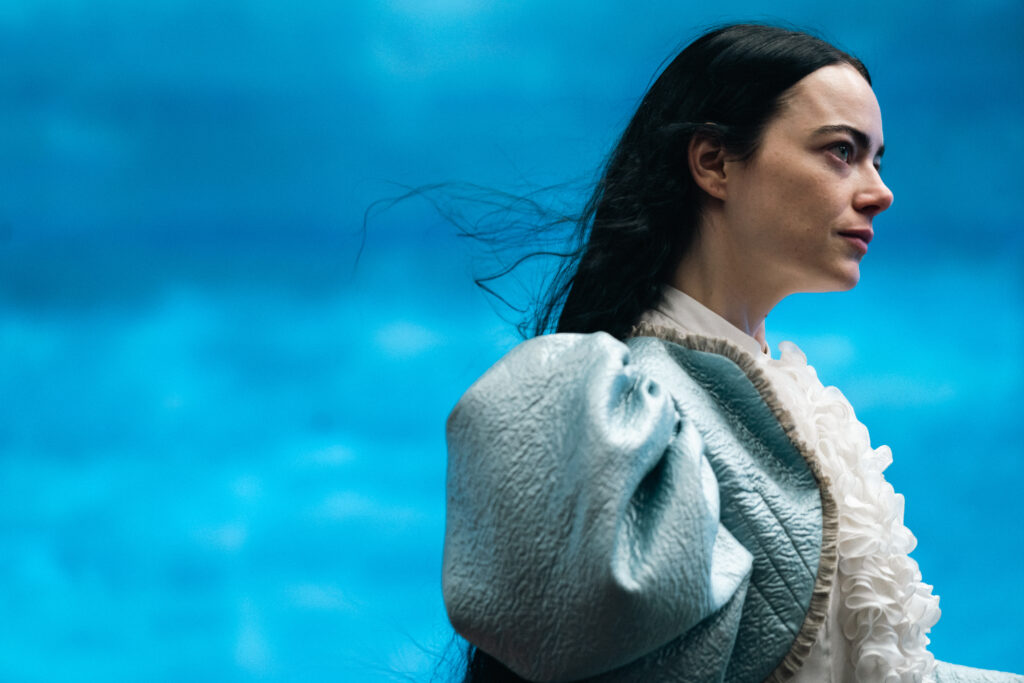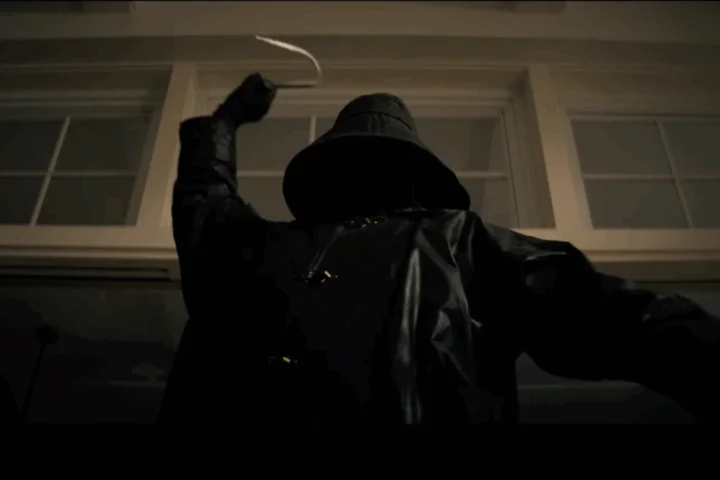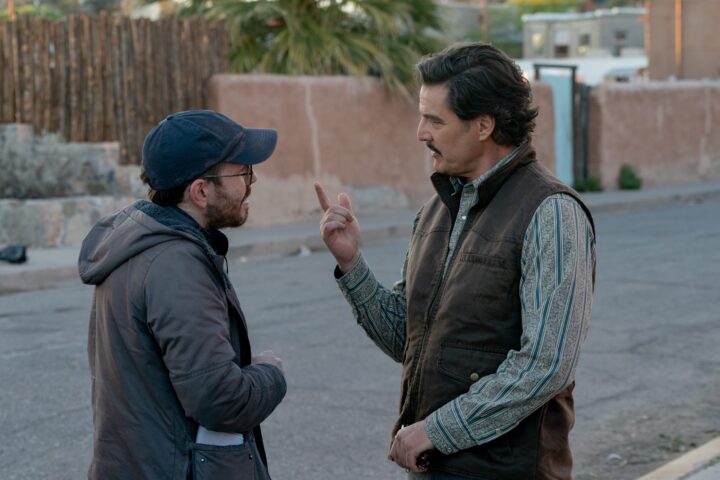In Yorgos Lanthimos’ brilliant new vision Poor Things, Emma Stone plays a turn-of-the-20th-century Londoner who, through a spectacularly conceived series of events, both dies and is brought back to life by doctor Willem Dafoe, a god complex mad scientist whose unorthodox experiments play like Metamorphoses’ Pygmalion by way of Mary Shelley. Stone’s instantly iconic Bella Baxter, ready to re-enter polite society with the rapidly evolving mind and body of a child-woman seeking social, sexual and intellectual stimulation, undergoes an odyssey that will cross continents and milieus in search of pleasure and independence.
For certain-to-be Oscar-nominated costume designer Holly Waddington, the character’s rapid evolution from childlike naiveté to post-modern empowerment presented an opportunity to incorporate both historic and contemporary styles, the costumer’s extravagant inventions in concert with Lanthimos’ audaciously heightened aesthetic (realism it is not).
Waddington, whose academic career included fine art studies at Oxford University and scenography at Trinity Laban, has worked on such pictures as Lady Macbeth, Ginger & Rosa, War Horse and Lincoln. For the experienced designer, Poor Things presented a challenge to conceive of what would ultimately become a collection of grandly ornate onscreen creations both period specific and uniquely expressionistic. I recently met with Waddington, whose creative genius complements that of Lanthimos in every frame of Poor Things, for a chat about costuming the year’s most intriguing movie character.
Holly Waddington: Did you enjoy Poor Things?
I loved it. It’s one of my very favorites this year.
HW: Oh good! I’m so glad.
Here we have the most eccentric, unique—not just director—but character in a movie this year.
HW: Yes!
She is a character we watch with fascination as she rejects all of this polite society and finds her way through this whimsical version of the turn of the 20th century. For you creating this costumes, certainly you were probably not guided by realism, per se. Tell me a bit about that. When you look at Bella Baxter and your vision of this movie, what was your guiding principle?
HW: I was trying to find a bit of language with the clothes that was a bit sci-fi, but not obviously. I wanted it to capture a sense of the late 19th century, and and the sort of ingenuity of that. But not slavishly at all. It needed to feel sort of modern, but not like a fashion thing, and that was an expression of her freedom and sense of being free I guess.
Also needed to be shed easily. And evolves as she evolves.
HW: Yes, to be able to be taken off and to be quite light. Not stodgy and heavy and no corsets. And yes, to evolve as she evolves. It was quite a tricky costume plot to come up with.
A costume plot.
HW: A costume plot! It was really hard to work out because it had to support her journey through the film and there were many stages to her development as she rapidly goes from being a small child to a fully-fledged, grown up woman who has a very clear sense of her purpose and trajectory moving forward. It needed to fulfill a lot of criteria. It was tricky and fun!

How much of the concept comes from thinking about the functionality of the clothing for the actor in the moment it is worn? Is that an initial concern?
HW: It does have to be. But I am never thinking about functionality. Never. I am not. That would come afterwards. I am probably the least practical person ever. I had an assistant on this job thinking about the practicalities. I am passionately not doing that until I have the idea right, because you can always find the practical solution later. I am always thinking about the most effective way to communicate the character to best tell the story.
Did Yorgos share his vision for this or did you have a good deal of autonomy?
HW: I did have a lot of autonomy. Yorgos is a real risk taker and a proper artist. He picks his collaborators and sets them out on their way, and what it’s like to work on one of his projects is that you don’t quite know if you are doing it right. You are just kind of hoping. There is this David Bowie quote about how if you are feeling comfortable when you are making things that is not right. I never felt that more than doing Poor Things. I always felt a strong sense of anxiety because it was tricky trying to find this language.
So initially, you take the script and…
HW: Break it all down.
And for this film that would seem very ambitious. To begin with, you are in a period. It’s also a transitioning period in the world and society. It also takes places in different milieus while crossing time. Was it daunting to consider getting from “here to there” across this vast spectrum?
HW: It was a bit challenging. I don’t think I realized until I was doing it how challenging it was. I think I definitely am someone who is quite gung-ho, so I just loved the project so much that I wanted to to it! I was never thinking, ‘Oh, this is so challenging.’ Then it dawned on me as I was doing it that it was not just a few clothes and there would have to be loads of clothes and they could not all be the same. She could not have those flopping dressing gowns that she wears in her child phase- she couldn’t have those on the cruise ship. It needed to really jump around.

So when we see her at the end of the film ask she is walking with Ramy Youssef by the water and they are negotiating their relationship, and we look at her in that particularly elaborate and beautiful costume, we recognize the arc to which you are referring. The costume helps us to truly understand what a long way this woman has come, from Pygmalion to her own agency.
HW: Yes! Great. I had this book and it was a giant folder and a page for each costume. It was really a book describing the journey, and I remember thinking the hardest part of the job was to work out what she was wearing—before I could even design or choose fabrics—to work out conceptually what it needed to be.
Are there particular nuances to consider when dressing Emma Stone, the actress?
HW: What do you mean, exactly?
Is there something particular to Stone, either in her frame, carriage, style, etc. that would factor into how you might design something she would wear?
HW: No, because she can just wear anything. She can embody anything. That’s not just because she is good looking and slim, but I didn’t really need to work around her physicality or taste or anything like that. She is probably the least vain actor I’ve worked with and she has no regard for whether she looks good or not. What always mattered to her was the idea. She is extraordinarily busy so we had a fit model, and Emma would say, ‘Just tell me what wedding dress is going to be like. Why is it see-through? Why has it got this? Tell me why.’ I would reply, ’Oh, because it’s like a cage. That is a metaphor for marriage for your character.’ She would say, ’Okay, yes, why this, this and this?’ For her, as long as I could explain what I was doing and she agreed with it, we would do it, regardless of whether she felt like it suited her. But everything did suit her and she looked good in everything. She can make everything work, really!
Let’s talk about the French bordello sequences and the costuming of all the women, which is beautifully creative and cool. What were you thinking about creating designs for each of the women in the house, including the madame, played by Kathryn Hunter?
HW: Oh, god, I loved doing her costume! I loved doing that character so much. For Kathryn Hunter’s character, Madame Swiney, I wanted her to feel almost like she was upholstered.

Were the tattoos your decision also?
HW: The tattoos were the idea of (make-up artist) Nadia Stacey, but it was a really great collaboration between Nadia and myself. Kathryn’s physicality really impacted on that design. She is a very slight woman and comes from the world of physical theater. So in her fitting she was jumping about the furniture like a sort of spider monkey! On the one hand, I wanted her to feel like a piece of upholstered furniture, like this massive armchair that was rooted in this place, and for the fabrics to feel dense and stodgy and really of the period. That dress is very much of the period but I played with the shape. And I loved the idea that we would not see any hair. She would always have this silk turban, almost like her hair underneath could potentially be grotesque. And then Nadia sort of flew with the idea and wanted to have a scene where she was exposed in this little stocking top, fully tattooed, where we really get a sense of her physicality.
And then the other women in the brothel- their defining feature is that none of them wear corsets, which is unusual for a Victorian brothel, and none of them wear black, red or any of the colors that we associate with bordellos. They are all in skin colors. That was a decision I thought would be a good to explore. And they have their breasts exposed, so it really was about celebrating their bodies, which were different shapes and sizes. I had this incredible fabric that was textured wool that had latex poured all over it. It had this visceral quality. We decided to make them all costumes from it and then layer it with latex and silk. But all of the color palette came from a range of skin tones.
It’s very striking.
HW: Thank you. I am glad you noticed it as I feel like it’s quite hard to see that!
I was sitting in the front row by myself and as you know, the film is aesthetically overpowering. I was close to your creations.
Good! And yes, it is very intoxicating.
Great to meet you.
HW: Yes, lovely!
This interview has been edited for length and clarity.



